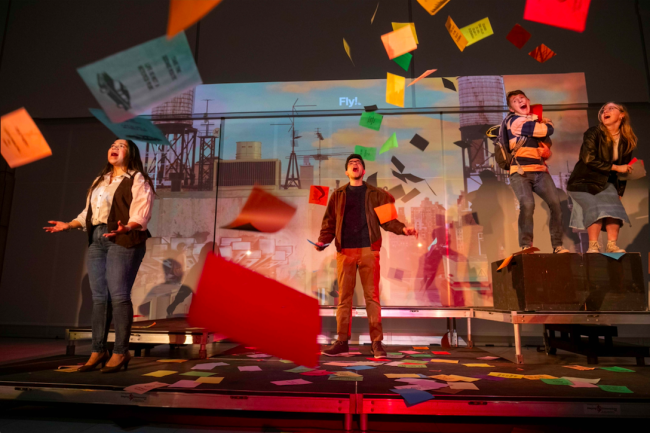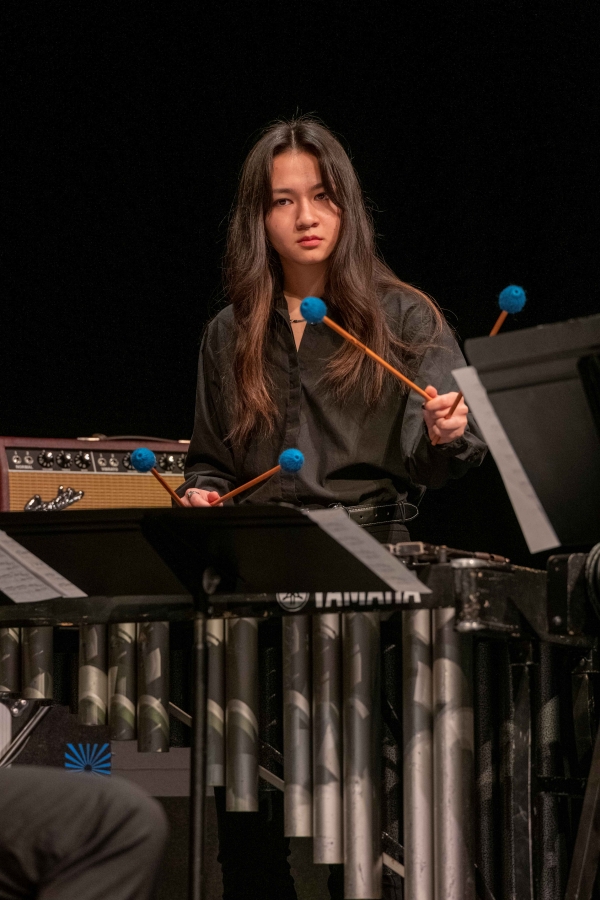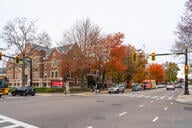You have /5 articles left.
Sign up for a free account or log in.

The musical “Ordinary Days” is one of the performances that students have produced on the RIT campus over the course of the semester.
Rochester Institute of Technology
The Rochester Institute of Technology is a place where “everybody can find somebody who shares their interests,” according to first-year student Mia Clarizio.
She speaks from experience. In her first semester at RIT, Clarizio, a percussionist since the seventh grade, was surprised by the university’s limited array of student percussion ensembles. So she printed out fliers, inviting fellow mallet players to join a server on the instant messaging platform Discord, and by the end of the week had enough interest to create the Small Mallet Ensemble—a group of four mallet players and one student on the cajón, a Peruvian drum.
A few months later, the grassroots ensemble was invited to participate in Ovation, a yearly talent showcase with a cash prize.
“When we played for Ovation, I just felt so honored to be able to play for my community and peers because we aren’t even an official club; we don’t have enough members and I didn’t feel like doing the paperwork. So, making it that far … was already a huge deal to me,” she said. “It’s something that I want to build off of in the coming semester.”

Rochester Institute of Technology
Clarizio is part of a rapidly growing community of actors, artists, musicians and dancers at RIT anchored by the university’s Performing Arts Scholarship program, launched in 2019 to attract more artistic applicants and to support them in pursuing their passions while there. The scholars are awarded an annual, renewable sum of between $500 and $2,000 and are required to participate in the performing arts on campus; 126 students received scholarship the first year, but that number grew to around 500 in last fall’s incoming class.
At the start of the next academic year, there will be a total of roughly 2,000 Performing Arts Scholars on campus, making up about a tenth of the student body.
RIT has emphasized the performing arts since long before the scholarship program was created; to take one example, the annual Juggle-In, a celebration of the circus arts hosted by the Juggling Club, dates back to 1978. But the launch of the performers’ program marked the beginning of a renewed focus on the performing arts on campus.
Since then, that effort has manifested in a symphony of ways. The university launched a School of Performing Arts this academic year under the direction of Erica Haskell, an ethnomusicologist. It also funneled funds into performing arts spaces, creating a new rehearsal and dance instruction space, a 180-seat black box theater, a 750-seat venue and a 1,500-seat orchestra hall. The school plans to hire nine or 10 new faculty members in the coming years and may eventually develop new interdisciplinary majors that merge the performing arts with technology. Haskell also aims to build connections between RIT and the surrounding arts scene in Rochester, as well as bolster the university’s existing relationship with the Eastman School of Music at the University of Rochester.
RIT is not the only STEM-focused university to invest heavily in the arts. The Massachusetts Institute of Technology has worked to allow students to integrate scientific and artistic disciplines into their studies. And in some circles, Carnegie Mellon University is as renowned for its School of Drama as for its achievements in science and computing.
But RIT is focused on a specific goal that could set it apart: the university wants to boast the best nonmajor performing arts program in the country.
Well-Rounded Students
It makes sense for a technical institution to invest so much in the performing arts for two key reasons, Haskell said. For one, musicians, dancers and actors tend to be collaborative and think creatively, which helps make them exceptionally thoughtful, well-rounded and open-minded in the classroom and beyond.
“There are all kinds of stereotypes about the STEM student [who is] singularly focused on math or science,” she said. When you take a student like that who is also a passionate performer, “you have a full package of a student who will be successful after they graduate.”
The performing arts also positively impact mental health, said Joy Allen, the chair of the music therapy department at Berklee College of Music in Boston. Not only do they make us feel happier and calmer, but they also bring communities together by building bonds between performers and audience members.
“The arts give us an opportunity to connect with ourselves and others,” she said.
Clarizio said attending rehearsals for her music performance groups—both the Small Mallet Ensemble and the orchestra she performs with—allows her to take her mind off her classes and simply enjoy the music.
David Munson, RIT’s president, said that one of his goals when he stepped into the role in 2017 was to create joy on RIT’s campus that would stick with the students for years to come.
“We want to create these special experiences for our students and have them create experiences for each other,” he said. “It could be a musical theater performance or a rock band concert or whatever is being put on by our students … That gives me a lot of joy to see our community so happy and uplifted by what’s occurring. And it’s possible to do all that and they’re still studying just as hard for their exams and doing just as well in their courses and in their technologically based projects.”
There is a demographic reason to promote the performing arts as well: to try to encourage more women to attend RIT. Currently, the university’s student body is only 34 percent female. But 50 percent of its performing arts scholars are women, indicating that perhaps the program could draw more female students to the university.
RIT is not yet formally promoting the range of new arts offerings as part of its recruitment strategy; according to Munson, the institution is going to wait until the performing arts program is fully staffed before it begins to advertise it heavily.
But that doesn’t mean the arts offerings on campus haven’t already attracted some students. Performing Arts Scholar Brendan Cappon, a violist who is involved in both the orchestra and a string quartet that plays at events, said that when he was deciding where to attend college, he was unsure whether he wanted to pursue STEM or music. RIT’s blend of high-quality technical education and robust musical extracurriculars stood out to him.
Now he’s a fourth-year student aiming to graduate next year with three different degrees: bachelor’s degrees in biomedical engineering and mechanical engineering, plus a master’s in mechanical engineering. But he continues to spend his evenings in rehearsals, performances or private lessons—and even sneaks in an hour of individual practice between classes some days.
Music “has never felt like [something] I’m making time for so much as something that I actively need to make more time for because of the importance of it in my life and my education,” he said. “It’s something that I’ve always kind of put at the forefront.”
Yet he is careful to point out that he still has time to get his homework done—even on nights when he gets home from rehearsal at 8 p.m.




